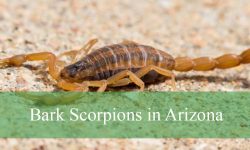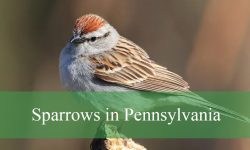In Tennessee, the diverse ecosystem plays host to a myriad of fascinating creatures, including a wide variety of caterpillars. These types of caterpillars showcase nature’s intricate tapestry, each species adapting to its unique niche within the state’s landscape.
One prominent example is the Eastern Tiger Swallowtail caterpillar (Papilio glaucus), a striking species with vibrant green coloration and distinctive black markings. Feeding on the leaves of various deciduous trees, these caterpillars undergo a remarkable transformation, eventually emerging as the iconic Eastern Tiger Swallowtail butterfly.
Another notable inhabitant is the Spicebush Swallowtail caterpillar (Papilio troilus), recognized for its vibrant green body and striking eyespots. This species is commonly found on spicebush and sassafras plants, blending seamlessly with the foliage as it prepares for its metamorphic journey.
In the woodlands of Tennessee, one may encounter the Hickory Horned Devil caterpillar (Citheronia regalis), a formidable-looking creature adorned with intimidating spines. Despite its appearance, this caterpillar is harmless to humans and plays a crucial role in the forest ecosystem, eventually transforming into the majestic Royal Walnut Moth.
The article below will explore 25 common caterpillars species found in Tennessee with pictures and their identification.
Different Types of Caterpillars in Tennessee
Monarch Caterpillar (Danaus plexippus)
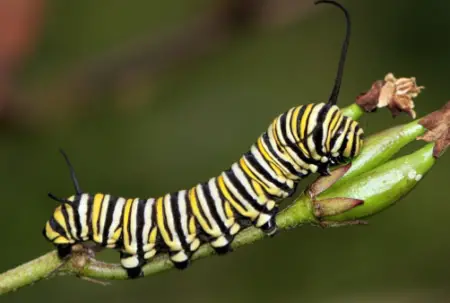
With its orange, white, and black wings, the Monarch Caterpillar (Danaus plexippus) is a well-known milkweed butterfly in Tennessee. There are five stages in its life cycle, and they are all associated with skin loss. Approximately five days pass between each stage, depending on the temperature and food availability.
After hatching, the caterpillar has a grayish-white to pale green appearance. The front tentacles are gradually revealed as dark lines with small bumps on a green background. Its design is altered in the second stage to incorporate white, black, and yellow bands. Its yellow triangle on top of its head is surrounded by two yellow bands, and its black tentacles are beginning to spread out.
Silver-Spotted Skipper Caterpillar (Epargyreus clarus)
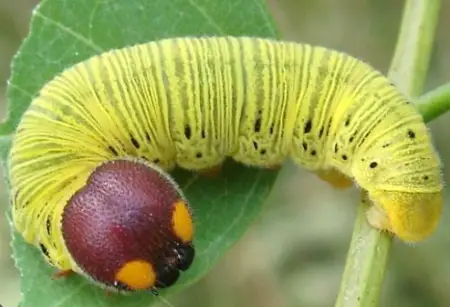
In Tennessee, fields, gardens, and the edges of woodlands are common places to spot the Silver-spotted Skipper (Epargyreus clarus). The leaves of a wide variety of plants, including pea-family herbs, trees, shrubs, and vines, are consumed by the caterpillar.
These caterpillars, which can grow to a length of 5 cm and have an average life span of 2 months, are found in wetlands and meadows. Wasps, birds, spiders, and frogs are some of the predators they have to contend with.
Banded Tussock Moth Caterpillar (Halysidota tessellaris)
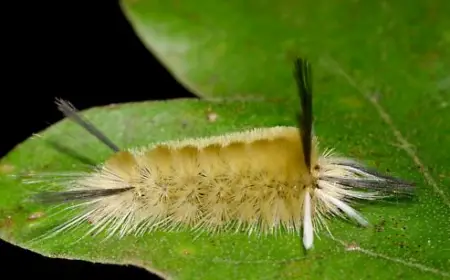
The Pale Tiger Moth (Halysidota tessellaris), also called the Banded Tussock Moth, was first found in 1797. When they are caterpillars, their bodies are covered in long, tufty hair that can be orange, yellow, or dark gray.
Their hair is long and the tops can be bright orange, white, black, or orange. These caterpillars can reach a maximum length of 3.5 cm when they are at rest on leaves. They pupate in gray cocoons filled with larval hairs over the winter.
White Furucla Moth Caterpillar (Furcula borealis)
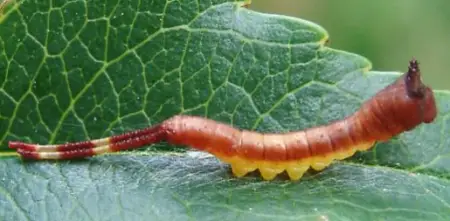
With its characteristic hair tuft between its head and upper torso, the White Furcula Moth Caterpillar (Furcula borealis) is easily identified. It operates mostly at night. Its body is either green or yellow, with a narrow, split tail that is connected to a dark brown, diamond-shaped mark in the center.
They usually eat the leaves of cherries, willow, and poplar trees. White furcula moths are harmless and do not present a risk to humans, despite their unusual appearance.
Rosy Maple Moth Caterpillar (Dryocampa rubicunda)
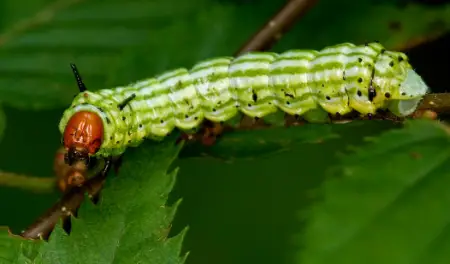
The green-striped mapleworm, or Rosy maple moth caterpillar (Dryocampa rubicunda), has five larval stages. At first, it has a dark head and a pale yellow-green body with faint green lines. The leaves of beech, oak, and maple trees are the main foods they eat. They give up eating as adults. It’s best to avoid the caterpillars because they can sting you severely if you come into contact with them.
Snowberry Clearwing Caterpillar (Hemaris diffinis)
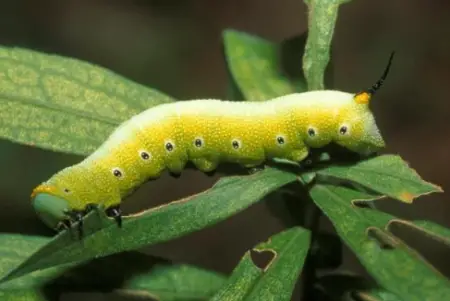
The main color of the Snowberry Clearwing Caterpillar (Hemaris diffinis) is bright green, with black dots close to its breathing apertures. Its tail spike is black with a yellow base, and it has a yellow ring around its head. They eat a variety of plants, including horse gentian, dogbanes, buck brush, blue stars, and honeysuckles. It’s noteworthy that these caterpillars pose no threat.
Pipevine Swallowtail Caterpillar (Battus philenor)
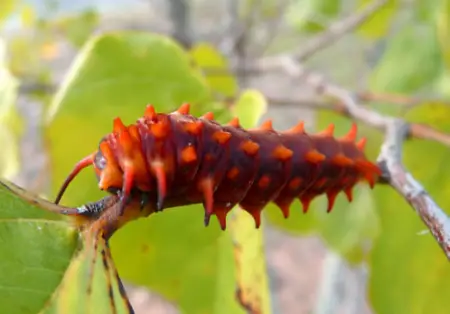
The Pipevine Swallowtail Caterpillar (Battus philenor), among other places where its preferred plant, the pipevine, grows well, is usually found in woodlands, open fields, and gardens. Their colors range from a deep reddish-brown to a brown tone, often with a subtle purple undertone around the edges. Two inches is the longest they can get.
These caterpillars only eat the leaves of birthwort and Dutchman’s pipe; they are poisoned by the plant that serves as their lethal host.
Cloudless Sulphur Caterpillar (Phoebis sennae)
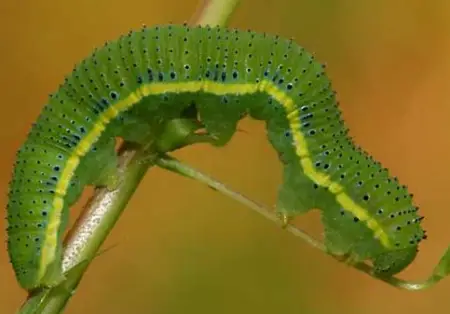
The Phoebis sennae butterfly, which is also known as the Cloudless Sulphur Caterpillar, has peculiarly angled wings. The caterpillars have stripes along the sides and are colored yellow or green when they hatch, with black dots splattered across their backs.
They eat leaves and flowers, especially those belonging to the Cassia and Senna families. The caterpillars consume the poisons found in these plants, which make them poisonous and repulsive to potential predators.
Red-Spotted Admiral Caterpillar (Limenitis arthemis)
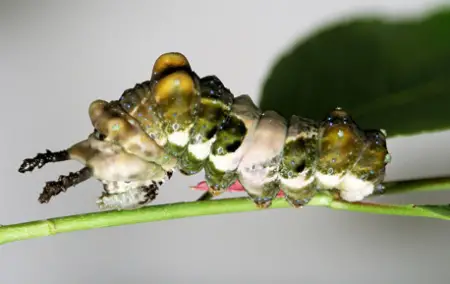
Throughout its various stages of development, the Red-Spotted Admiral Caterpillar (Limenitis arthemis) resembles bird droppings. Its colors range from green to brown, with creamy patterns, and it has two distinct thoracic horns. To distinguish it from the viceroy caterpillar, look for rounded projections surrounding its head in place of spikes.
They are native to North America and feed mostly on the leaves of willow, poplar, and aspen trees, though some also enjoy the leaves of black cherry and yellow birch trees. Despite its unusual appearance, this caterpillar is harmless and does not pose a threat to people.
Army Cutworm Caterpillar (Euxoa auxiliaris)
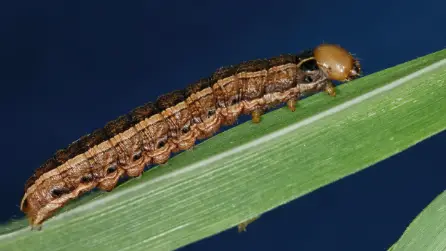
To hide during the day, the Army Cutworm Caterpillars (Euxoa auxiliaris) construct mesh-like shelters out of the turf. When fully developed, their length ranges from 1½ to 2 inches, and their colors range from green to black. They have darker top sides and two distinct stripes, one orange and the other dark, on each side. They are harmless to people and consume a wide range of foods, such as crops, grasses, and wild plants.
Giant Leopard Moth Caterpillar (Hypercompe scribonia)
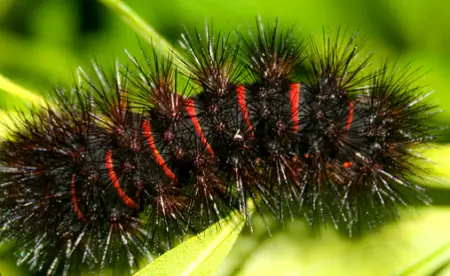
Giant Leopard Adult Moth Caterpillars have strong black hairs that emerge from brownish nodules and a striking black color with red spaces between segments. They feed on the leaves of various plants, including citrus, violets, dandelions, and honeysuckle. They may appear menacing, but they are completely harmless.
Luna Moth Caterpillar (Actias luna)
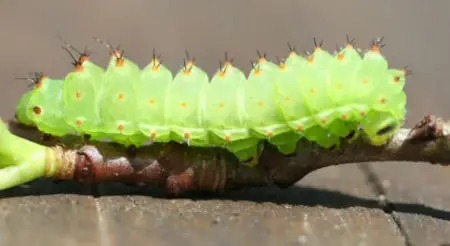
Actias luna, also referred to as the American moon moth or a large variety of silk moth, is the Luna Moth Caterpillar and can grow up to 4 inches in length. As it ages, the natural green color fades to patches of magenta and yellow.
Though neither the moths nor their caterpillars are harmful, people may perceive the moths, which primarily eat the leaves of walnut, hickory, and pecan trees, as frightening due to their vivid colors.
Common Buckeye Caterpillar (Junonia coenia)
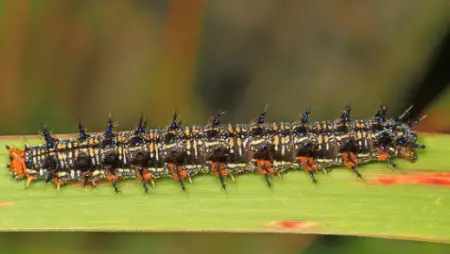
Common Buckeye Caterpillar, or Junonia coenia, is a 1.5-inch caterpillar that does best in wide areas with little vegetation. Their bodies are black, covered in bright patterns of beige, gray, and white. White streaks and orange dots adorn the sides.
Buckeye caterpillars, in contrast to many others, prefer to be by themselves. They mostly consume vibrant-flowered Gerardia, weed plantains, snapdragon, and other native weeds. They are not very dangerous to humans even though they have spines.
Gulf Fritillary Caterpillar (Dione vanillae)
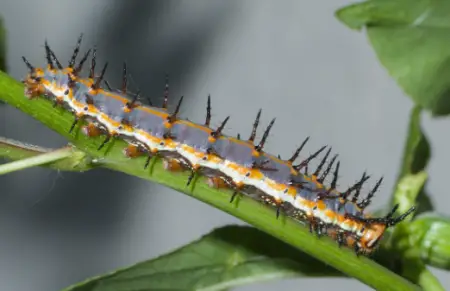
The Gulf Fritillary Caterpillar (Dione vanillae), which develops into an eye-catching orange butterfly with extended wings, is frequently connected to the passion butterfly family. From brilliant yellow eggs hatches the transparent caterpillar inside. When the caterpillar is fully grown, it has a bright orange color and black prickles.
The passionflower, particularly the purple varieties, is their primary food source. Birds are deterred by the venomous larvae and repulsive adult Gulf fritillary butterfly.
Stinging Rose Caterpillar (Parasa indetermina)
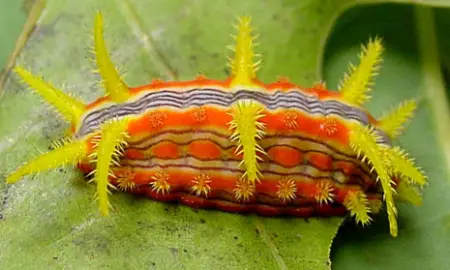
The Parasa indetermina, sometimes called the Stinging Rose Caterpillar, has an almost artistic appearance due to its striking orange, purple, red, and yellow hues. It usually eats the leaves of trees such as apple, hickory, and dogwood. It can be identified by its seven pairs of horn-like spines, one substance inside each pair that causes irritation. In the event that something accidentally comes into contact with human flesh, the spine may break and cause excruciating pain.
Spun Glass Slug Caterpillar (Isochaetes beutenmuelleri)
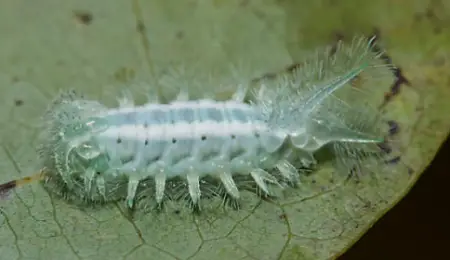
The Spun Glass Slug Caterpillar (Isochaetes beutenmuelleri) is a translucent, needle-like caterpillar that looks like delicate spun glass in its larval state. Its primary food source is swamp oak trees. Handle this caterpillar with caution as its spiky, poisonous hairs can irritate skin when touched.
Tiger Moth Caterpillar (Arctia caja)
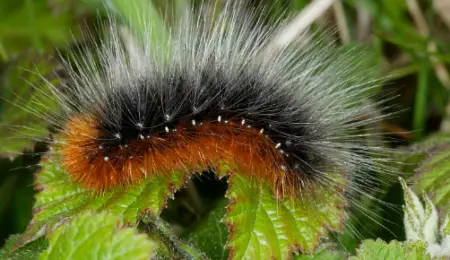
The massive black body and thick covering of ginger and black hairs set the Tiger Moth Caterpillar (Arctia caja) apart. Adult moths consume only the nectar of flowers, along with a variety of wild plants and greens. Take caution when handling these caterpillars as they contain strong poisons that can cause nausea, severe stomach issues, and in severe cases, even death. Occasionally, their toxicity is used in agriculture to manage pests.
American Dagger Caterpillar (Acronicta americana)
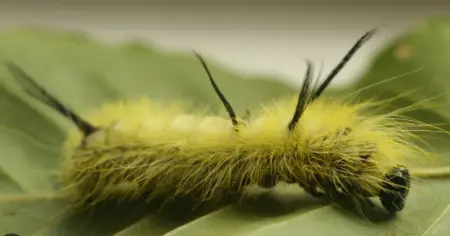
The fuzzy-looking hair of the American Dagger Caterpillar (Acronicta americana) ranges in color from yellow to pale green to white. Its distinctive features are the four small black hair tufts on its first and third abdominal segments, as well as one more near the end of its tail.
They are frequently seen in parks, gardens, backyards, and woods. They eat the leaves of many hardwoods, such as ash, elm, and alder. You should avoid touching them despite how cute they seem because their hairs could burn, irritate, or cause rashes on your skin.
Fall Webworm Caterpillar (Hyphantria cunea)
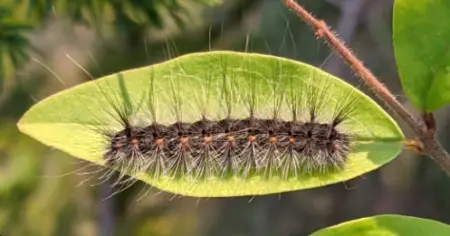
The Fall Webworm It is commonly known that Tennessee’s common caterpillar, prefers to consume ornamental plants and trees. The fluffy, vibrant white or yellow coloring of the mature fall webworm moth is what sets it apart.
These caterpillars feed on more than ninety different kinds of trees that shed their leaves, such as walnut, hickory, cherry, crabapple, and birch. They are not picked by their hosts. Though they enjoy weaving webs around trees, they are harmless and not a threat. Generally speaking, they are more of a nuisance than a threat.
Yellow-Striped Oakworm Caterpillar (Anisota peigleri)
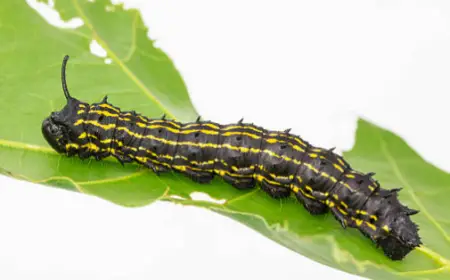
The Yellow-Striped Oakworm Caterpillar (Anisota peigleri) is a stunning black caterpillar with bright yellow stripes that grows up to be a maximum of two inches in size. They have black extensions with a row of tiny spikes adorning their second thoracic segment.
These caterpillars congregate in groups during the early stages and primarily eat the softer parts of the leaves, frequently eliminating them almost completely. Mature caterpillars are safe and pose no threat to humans, despite their seeming prickliness.
Pearl Crescent Caterpillar (Phyciodes tharos)
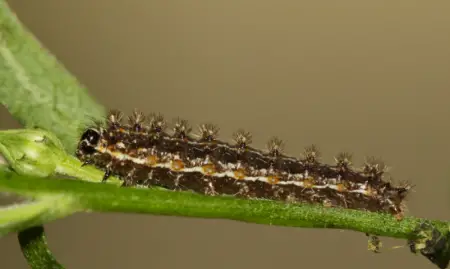
Phyciodes tharos, better known as the Pearl Crescent Caterpillar, is a beautiful sight that is frequently seen in Tennessee’s open spaces, such as parks, roadside areas, and light pine forests. Its sides have subtle, creamy stripes that range in color from smoky gray to deep brown. It has lots of tiny, branching spikes.
These caterpillars feed in groups during their early life, mostly on asters. If you come across one, don’t worry—they are not dangerous or harmful.
Imperial Moth Caterpillar (Eacles imperialis)
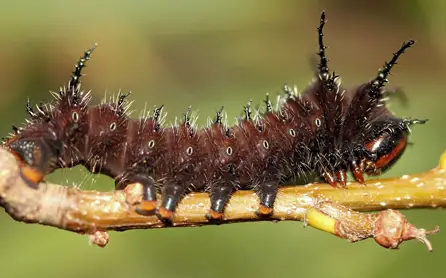
When the Empire Moth Caterpillar (Eacles imperialis) first emerges as tiny, orange beings less than half an inch in size, it is quite a sight to behold. They are easily recognized by their distinctive black spines. They develop into large, up to 5-inch-long caterpillars with patterns that are either bright orange, brown, or green.
They eat a wide range of things, but they especially like eating maple, oak, and pine trees. Their spiky exoskeleton contains venom that can sting when handled and cause allergic reactions in certain people, so it’s best to be cautious.
Eastern Tent Caterpillar (Malacosoma americanum)
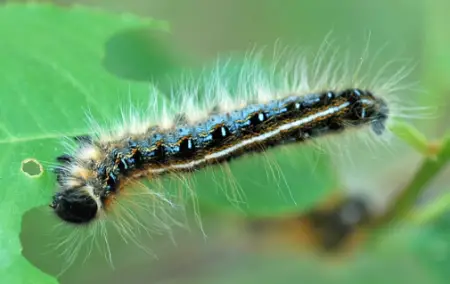
Known for their gregarious behavior, hundreds of Eastern Tent Caterpillars (Malacosoma americanum) build communal nests to share food and warmth. These caterpillars have soft bodies that are colored in shades of orange, black, and blue. They have a distinctive line down their backs and tufts of hair down their sides. They are about two inches long when fully grown. Usually, they eat the leaves of wild crabapples, apples, and cherries.
People Who Read This Also Read:

